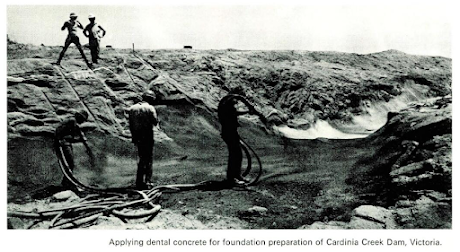Cardinia Reservoir is Victoria’s second largest water catchment with a storage capacity of 287 Gigalitres and is located within the boundaries of Cardinia Shire, on over 2600 hectares (6500 acres). As well as supplying water to our region, it receives water from both Silvan Reservoir and when in operation, from the Victorian Desalination plant at Wonthaggi. https://www.melbournewater.com.au/water-data-and-education/water-storage-levels/water-storage-reservoirs/cardinia.
The main embankment is 86 metres high and 1.5 kilometres long.
Cardinia Reservoir is Melbourne Water’s second largest reservoir after Thomson Dam, and has an approximate total storage volume of 287 GL. It was constructed between 1970 and 1973 to secure water supply for Melbourne’s southern and south-eastern suburbs. As an off-stream storage reservoir, it has no effective catchment of its own and receives water transferred from Silvan Reservoir and the Victorian Desalination Plant. Water is also transferred from Cardinia Reservoir to most parts of Melbourne depending on how our supply system is managed.
(https://www.melbournewater.com.au/building-and-works/projects/cardinia-reservoir-dam-upgrade)
In the 60s, with a quickly growing population, the need for additional water supplies was identified. Originally, Cardinia Creek was not identified as a potential location, but after serious lobbying from Councillor Brown of Sherbrooke Shire, drew the attention of Melbourne Metropolitan Board of Works (MMBW) planning officers. (Hills of Home: a bicentennial history of the Shire of Sherbrooke by A.P. Winzenried: [Melbourne]: Arthur Paul Winzenried, 1988, pg. 247)
In 1966, the Canberra Times published details of the proposed reservoir, which was estimated to cost $15million to construct, noting however that this did not include tunnelling costs. At that time, its name was Cardinia Creek Reservoir, based on its location across the Cardinia Creek catchment.
Originally scheduled to begin construction in, severe drought in 1967-68 and the 1968 bushfires identified the necessity to bring the schedule forward. By September 1968, 85 properties had been purchased, out of the 325 required for the reservoir’s building. (Winzenried)
The Snowy Mountains Hydro-Electric Authority reported on their involvement in the project in their 1968-69 annual report. “The Authority is undertaking the investigation, design and preparation of specifications for Cardinia Creek Dam…… The Authority was subsequently asked to undertake final investigation and design of the project. This commenced in January 1969……” It was expected that the project would go to tender in October of that year.(https://nla.gov.au/nla.obj-845449891/view?sectionId=nla.obj-1104261885&searchTerm=%22cardinia+creek+dam%22&partId=nla.obj-845955885#page/n46/mode/1up/search/%22cardinia+creek+dam%22)
In their 1969-70 Annual Report, the SMHEA reported that tenders for the work closed in January 1970 and construction commenced on the 13 May 1970. (https://nla.gov.au/nla.obj-843195246/view?sectionId=nla.obj-1122090671&searchTerm=%22cardinia+creek+dam%22&partId=nla.obj-843801411#page/n24/mode/1up/search/%22cardinia+creek+dam%22)
 |
| Snowy Mountains Hydro-Electric Authority Annual Report 1969-1970 |
By 1971, work had commenced on the tunnel connecting the new Reservoir with the Silvan Reservoir and the MMBW water supply network from Maroondah Reservoir. (Winzenried).
In 1972 the Age reported the budget was $11.4 million dollars and that construction was well under way (begun in May 1970) as a joint venture between Fluor Australia Pty Ltd and Bown and Root (Australia) Pty Ltd for the MMBW. $1 million was also allocated to landscaping and facilities, to develop the area as a recreational reserve. These facilities, under the name Cardinia Reservoir Park, are managed by Parks Victoria. (Age 24 April 1972 https://news.google.com/newspapers?id=eMcQAAAAIBAJ&sjid=spADAAAAIBAJ&pg=6934%2C5118610)
When Cardinia Reservoir officially opened in July 1973, Melbourne’s water capacity was almost doubled. The dam would not be fully operational until it was filled, which took until 1977, and this was achieved primarily through water transfers from Silvan Reservoir. The Canberra Times reported on the 2nd May 1973, that the final cost of the dam was $26.7 million. (https://trove.nla.gov.au/newspaper/article/110707523?searchTerm=%22cardinia%20reservoir%22)
At some stage, the name changed from Cardinia Creek Reservoir to Cardinia Reservoir (although I have been unable to discover details of this change). The name change could potentially have happened to save confusion with projects proposed for other locations along Cardinia Creek.
When the Melbourne Metropolitan Board of Works was dissolved in 1991, the new authorities created to manage the water supplies and parks, took over management. This was Melbourne Water for managing the Reservoir and Parks Victoria for Cardinia Reservoir Park. (Melbourne's water catchments: perspectives on a world-class water supply by James I. Viggers, Haylee J. Weaver and David B. Lindenmayer, Collingwood (Vic): CSIRO Publishing, 2013, pgs. 98-99)
More recently, although the desalination plant at Wonthaggi was completed in 2012, it did not start sending water to Cardinia Reservoir until 2017. There was an annual top up in following years as well. (https://www.abc.net.au/news/2017-03-19/victoria-desalination-plant-finally-delivers-water/8367554)
Cardinia Reservoir is still Victoria’s second largest water supply, and continues to supply Melbourne's southern and south-eastern suburbs, and the Mornington Peninsula. Cardinia Reservoir itself is still managed by Melbourne Water and Cardinia Reservoir Park by Parks Victoria.


